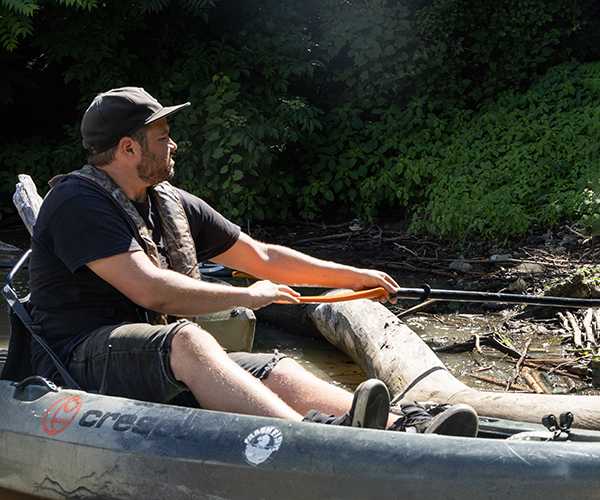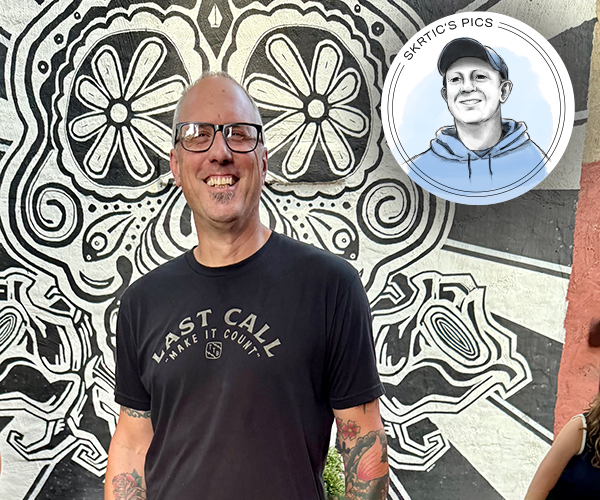Eda and William Halberg get excited describing their spring 2020 tour at a Twinsburg recycling plant, and not just because it was the last time they participated in a group activity before the pandemic hit. This couple has recycled for more than 50 years.
Eda watched in fascination as employees worked alongside a single-stream recycling line as a vacuum-type system pulled out certain materials from the conveyor belt. Customers like herself have always separated plastics, cardboard and aluminum items before putting them in recycling carts, but she learned they’re in the minority.
The couple’s biggest takeaway from the tour at the Kimble Twinsburg Recycling Center was learning about how grocery plastic bags can work their way through the recycling facility — catching, wrapping and clogging up sorting machines, sometimes temporarily stopping production on the recycle line.
“I hate to waste things and the landfills bother me,” she says.
When it comes to recycling, many of us think we’re doing it right. But contamination is a huge and costly problem that a lot of people contribute to unintentionally. On average, about 25% of stuff that people place in their recycling are the wrong things, including food waste, fast food containers or garden hoses. These items are not recyclable and must be removed and landfilled, a leading factor to the increasing cost of recycling.
The costs of recycling has skyrocketed in recent years and the ripple effect includes cities like Cleveland where its recycling program is currently shut down — and has been since April 2020 when the city’s contract with a recycling company expired.
One of the main reasons it can’t secure a new contract? Contamination rates.
“The average contamination rate is 17 to 25%, and Cleveland’s rate was about 65%,” says Diane Bickett, executive director at Cuyahoga County Solid Waste District.
Starting in 2018 when prices plummeted in the global economy, Bickett says local cities did not pay to have recyclables processed. Costs now exceed the value to recycle. Cities went from having zero cost to paying recycling fees that range from $50 to $90 a ton, while it cost $45 a ton to send it to a landfill.
The city of Cleveland reported a second attempt to secure a new contract last April for these services. One bid would have charged the city tonnage costs that were well above market prices — potentially $6
million annually.
In a statement provided to Cleveland Magazine, the city acknowledges it is committed to recycling, while owning up to the challenges ahead. “From our perspective, we couldn’t continue with the status quo in light of the dramatic increase in costs we were facing, so we made the difficult choice to temporarily pause our recycling program while we completed a comprehensive review and update of our entire waste management operation.”
As of press time, that review is expected to be completed by late February.
“There’s no magic bullet to fix the city’s recycling challenges, but a greater effort towards helping residents understand the program and how to recycle is key to any program the city may implement,” Bickett says.
Companies nationwide are working on how to tackle containment and recycling issues. Three are involved in collaborations right now at Case Western Reserve University.
For instance, while the general public focuses primarily on thermoplastics such as the soft milk and juice jugs and applesauce jars, there’s a sizable amount of hard “thermoset” plastics, like a car steering wheel or most of an airplane, that is very difficult to recycle. Case researchers have found a new way to take the rigid thermoset plastics and break them down into a resin that can be used to either remake the product or make an entirely new product.
Upcycling polymers may be the most direct solution-oriented approach. The basic idea is that instead of separating recyclables on the front end, researchers combine both a mechanical process with a chemical process, but do it in a way that makes it more accessible and affordable for communities to recycle their plastics.
Joao Maia, head of the research project at Case Western Reserve University, leads a team that is developing and testing a technique with industrial partners (including a small company in Middlefield) with a goal of increasing recycling of polymer packaging to about 80%. The U.S. Department of Energy is backing the team of researchers’ efforts with a new $2.5 million grant.
From wrapping on meat packaging to a tube of toothpaste, these products play an important role in people’s lives, but they’re made from multiple polymers that cannot be recycled. “This project is going to try to find ways to recycle by separating the polymers first and then recycling each polymer individually,” Maia says.
While research and innovation are happening right in our own backyard, we still need to remain focused on how we’re handling our trash and recyclables right now. Northeast Ohio is known as a center for plastic production, including support for the auto, tire and rubber industries — all materials that can and should be recycled.
“It all ties in. Part of keeping these businesses successful and profitable is building on these long-term solutions,” says Grant Goodrich, executive director of the Great Lakes Energy Institute and the former interim CEO of Team NEO, a group responsible for business attraction efforts for the 18-county Northeast Ohio region.
Organizations like Rid-All Green Partnership and Rust Belt Riders — a Cleveland food waste recycling service that makes and sells compost to teach people about sustainability, soil and climate change — offer considerable hope and aren’t waiting for the city to step up.
Rid-All, located in the Kinsman neighborhood, has trained more than 3,000 people in its urban agriculture, sustainability, recycling and composting program in the last 10 years. Rid-All also offers 2-hour youth training programs aimed at eighth-graders in both public and private schools. Rid-All is known for bringing value back to low-income areas throughout the city by beautifying lots with flower gardens and vegetable gardens.
“Our goal is to transform communities,” says Keymah Durden, co-founder and executive director of Rid-All. “But in order to do that we need to be able to transform things that don’t have value into things that do have value.”
As for the city, it cites a few projects and partnerships of its own. In collaboration with Cleveland Neighborhood Progress, it secured a $476,000 grant to support its Circular Cleveland initiative. The hope is to develop a roadmap for what circular economy solutions — think using single-use plastic bottles as building materials — would work in Cleveland. It also has money set aside to launch a composting program at the West Side Market and $100,000 for small business support and $75,000 for small community grants.
These are all steps towards a sustainable future, but for a city that wants to be progressive and has vital assets such as Lake Erie, the Cuyahoga River and plentiful parks, it may not be enough.
“As a resident, I’m encouraged that the city is still working on the problem,” says Goodrich, “but at the same time, I’m frustrated that we’ve not been able to solve the problem sooner.”




